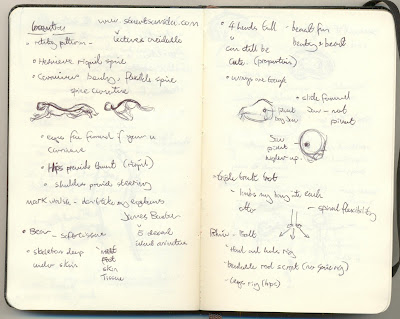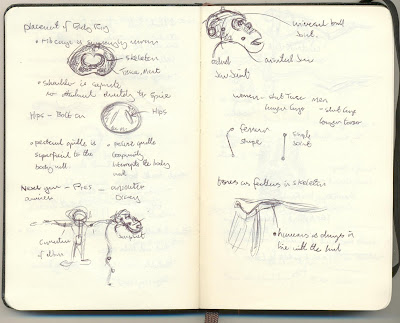Here's part 2 of the notes I will post on the Stuart Sumida workshop. Locomotion was the prepared presentation for this session however quite a few of us had unrelated questions that Stuart was all too happy help us with so if notes are a little random at times that would be why.
As previously stated the rigidity of a herbivore's spine is considerably more than a carnivore's. In the cheetah sketch above this demonstrates the range of curvature it's spine has when when running. to provide the agility of it movement the shoulder's provide steering whilst the hips provide thrust from a bolted position. Another interesting thing with carnivores is that their eyes face forward whilst a herbivores are positioned on the side of its head. This is basically due to a carnivore's hunt for prey requiring focus whilst a herbivore requires extreme peripheral vision to identify potential attackers in its surroundings.
The skeleton of a creature lies at its core, a bear has meat, fat, tissue and skin as well as fur all layered over the skeletal structure. This means that when imagining the skeleton for a fictional character these factors need to be taken into consideration to ensure that characters have believable movement. The Beast of "Beauty and the Beast" took anatomical reference from bears so that it would move correctly. The key characterised/stylised element was his 4 head tall proportion, allowing him to be threatening whilst retaining a "cute" factor. The caricaturing of proportion in characters is common and was an issue for the movement of the dog "Bolt". His legs would collide when walking and to combat this it meant changing the rigging to allow more flexibility in the spine, enough for the hind legs to alternate from the front on a cycle to give each leg room to stretch on a triple track trot. The Hips are an area of the body which require the pelvic cradle to lie just under the skin, allowing more freedom for the legs to move
The character when rigged in T Pose should have the arm's humerus always in line with the hand and should have its elbows lower than its shoulders to obtain the right curvature when animated. Female characters generally have a short torso and longer legs whilst male characters have longer torso's and shorter legs, this is useful when designing any character.
A interesting point and key to my work at this moment time is the orientation of the jaw and where its pivots are. The jaw can slide forward and backwards due to the muscle running from the ears downward, the actual pivot of its rotation is found a little higher. This requires, when rigging, 2 joints for each of these movements so the character has believable mouth movements.
I shall write up the remaining notes form Stuart Sumida's workshop in the next blog, hope these are of use to people, it's great knowing this same info is being used by the guys in the major studios.
Subscribe to:
Post Comments (Atom)




No comments:
Post a Comment